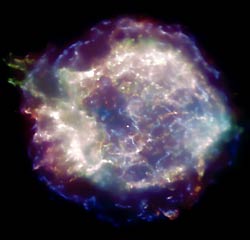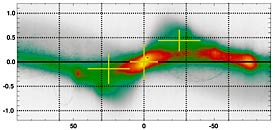
This image from NASA's Chandra X-ray Observatory shows detailed structures in the supernova remnant Cassiopeia A. The supernova that produced this remnant was probably the one observed by John Flamsteed in 1680 — the last observed supernova in the Milky Way Galaxy. Click on the image to view a larger version.
Courtesy NASA / CXC / SAO.
How often do supernovae pop off in our galaxy? Using the European Space Agency's Integral satellite, an international team estimates that one of the Milky Way's massive stars explodes about every 50 years on average. This estimate agrees rather well with previous studies, but the earlier work relied on more indirect methods.
The team, led by Roland Diehl (Max Planck Institute for Extraterrestrial Physics, Germany), used Integral to conduct a long-duration survey of the gamma rays produced by the radioactive decay of aluminum-26 in our galaxy. This rare isotope is produced by supernovae and has a half-life of 740,000 years.
A decaying aluminum-26 nucleus emits a gamma-ray photon at a characteristic energy of 1,809 kiloelectron volts. The gamma rays can travel across our galaxy virtually unimpeded by gas or dust; their penetrating power that makes them accurate probes of galactic aluminum-26 production. "It's an ideal measure of something that happens galaxywide," says team member Dieter Hartmann (Clemson University).

ESA's Integral satellite mapped the Doppler shift of emission from aluminum-26 in the Milky Way Galaxy. This rare isotope, which is produced by supernovae, is concentrated near the galactic center, where the most massive stars are generally found. The galaxy's rotation causes blueshifts for negative galactic longitudes (Crux, Centaurus, Carina) and redshifts for positive longitudes (Aquila, Cygnus, Cepheus), leading to the curved shape. Click on the image to view a larger version.
Courtesy MPE/Garching.
Each massive-star supernova produces about 0.0001 solar mass of aluminum-26. About 20,000 supernovae over the past million years were needed to create the observed amount of this rare isotope, which totals about 2.8 solar masses in our galaxy right now, the team reports in a paper published in the January 5th Nature. "That creates the diffuse gamma-ray glow that is distributed mostly in the inner galaxy, where most of the massive stars are," says Hartmann.
The inferred supernova rate also yields an estimate of the Milky Way's star-formation rate: about 4 solar masses of gas are converted into stars each year. Given the fact that most stars are less massive than the Sun, that figure translates to about 7 (plus or minus 3) actual new stars per year.
The group concedes that their inferred rate of about two supernovae (give or take one) per century assumes that the supernova rate has held steady over the past few million years, and that astronomers have a solid understanding of how many high-mass stars (which produce the supernovae in question) form relative to low-mass stars. Type Ia supernovae, which are produced by exploding white dwarfs, are not included in the count, but these are much rarer events.
Previous methods for estimating the supernova and star-formation rates relied on indirect methods such as recording the supernova rate in galaxies similar to the Milky Way and observing supernova remnants in our own galaxy. "Several different methods all point to a star-formation rate of several solar masses per year, and 1 to 3 supernovae per century," says Hartmann. "What we find exciting about our measurement is that it's independent, we're making a measurement of our own galaxy, and we have this beautiful unbiased view of the galaxy due to the penetration of the gamma rays. It's a straightforward method, and it agrees with various other techniques that are more complex."
The Integral team's result confirms what astronomers have known for decades: our home galaxy is long overdue for its next supernova. The last observed one in our galaxy was probably the one seen by British astronomer John Flamsteed in 1680, which produced the remnant known as Cassiopeia A. "We're apparently overdue for a few centuries," says Hartmann, "but that is, of course, a very short timescale. We can't make a statement about any particular century."
 0
0
Comments
You must be logged in to post a comment.